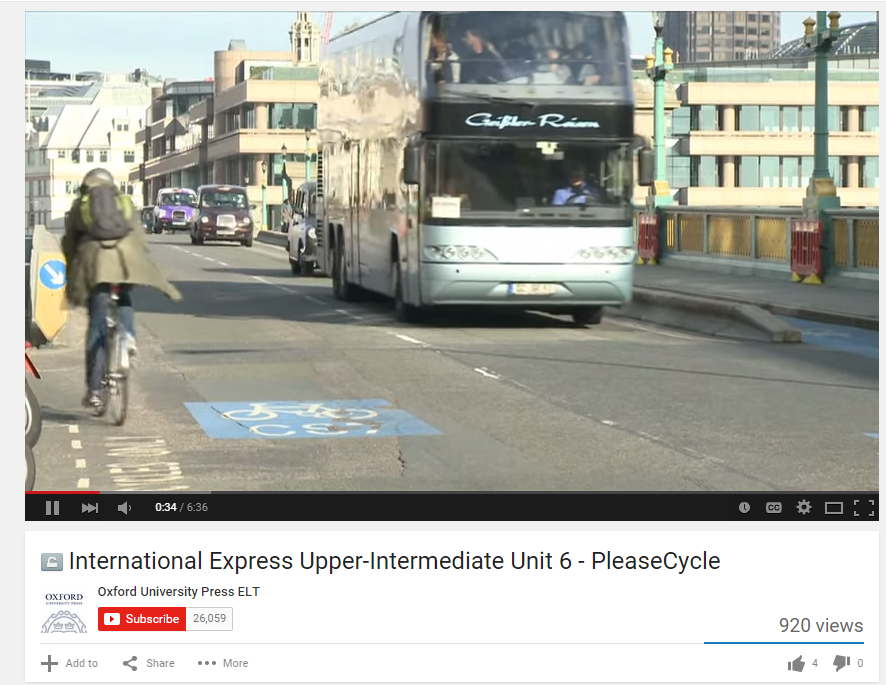
Before you watch
Try out some of these ideas to get your students thinking before they watch.
1. Discussion
You can focus on cycling from a number of angles, for example, you can think of it as a sport, a relaxing activity, or a method of commuting. Or you could discuss cycling equipment, safety issues, or infrastructure (for example, cycle paths). Find out quickly, open-class, how many of your students…
a. own a bike
b. cycle regularly (why/why not?)
c. participate in biking activities
2. Decide if these statements are true or false:
a. There are more bicycles than residents in the Netherlands.
b. In Groningen (in the Netherlands), the station has ‘parking’ for 1,000 bikes.
c. Spain has over 100 bike-sharing schemes.
d. The ratio between the number of cyclists in a city, and the number of bike-car accidents, is in inverse.
e. An adult regular cyclist has a fitness level of someone 20 years younger.
3. Brainstorm benefits and barriers
Move the discussion more closely to the video content by focusing on the benefits of and barriers to cycling. Put students into two groups: one group brainstorms the benefits, the other the barriers. Elicit 1-2 ideas per group, for example:
Benefits: keeping fit; saves on petrol
Barriers: you may need a change of clothes; lack of cycle paths
4. KWL Chart
Again, before they watch, you could do this with the audio. It’s an idea that works well with most listening or reading texts. Ask students to fill in a “KWL” chart: this looks at “what I know already, what I want to find out”, and – later – “what I’ve learnt”. Ask them to complete the first two sections alone (Know and Want), and then compare with a partner. Then, finally complete the third section (Learnt) afterwards (see exercise 8). This is very student-driven, as they are effectively making their own comprehension task.
5. Check key words
Tell the students they are going to watch a video about a new London scheme which aims to get as many people cycling to work as possible. Before watching the video, check students understand, and can pronounce, the following:
a. workforce
b. initiative
c. portal
d. gamification
While you watch
To maximize the learning opportunities, you need to set tasks for the students to focus on. The following exercise is taken from the video worksheet that comes with the International Express Teacher’s Resource Book DVD. All the worksheets are also available for free here. You just need your Oxford Teachers’ Club log-in details to view them.
6. Multiple choice
After you watch
7. Quick questions
Ask students for an immediate response.
What did they think?
Would they like to be involved in such a scheme?
Would PleaseCycle work for their company? Why/Why not?
How competitive would they be?
Would they encourage their company to register, and log their trips on the app?
8. Return to the KWL Chart
Go back to the KWL chart (see exercise 4) to check and complete part three.
Refer back to the “benefits” and “barriers” lists they brainstormed too.
9. Going into more detail
Before playing the video again, ask students what they can remember about Aegus Media, and Stravel. Both are mentioned in the video. Watch the video again, asking students to take notes about each company. Afterwards, let them compare notes in small groups.
Use the following questions to focus their ideas:
a. What did Aegus Media achieve using PleaseCycle?
b. How was their success measured?
c. What plans are there for Stravel?
10. Create a proposal
Each small group should imagine they are working together at a company. They need to create a proposal to convince the company managers to start using PleaseCycle.
Answers:
Ex. 2
a. T
b. F: 10,000
c. T
d. T
e. F: 10 years
Ex. 6
1. a
2. c
3. c
4. b
5. c
6. b
7. a